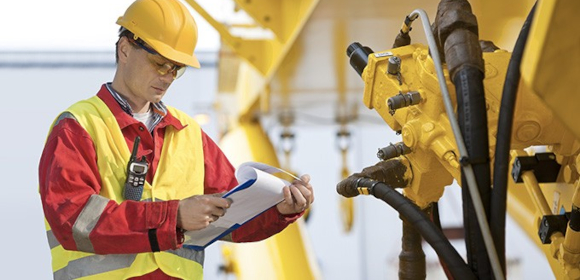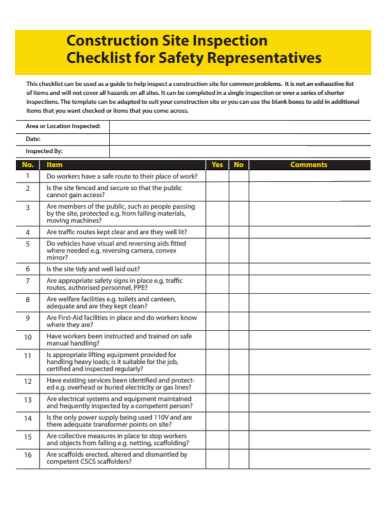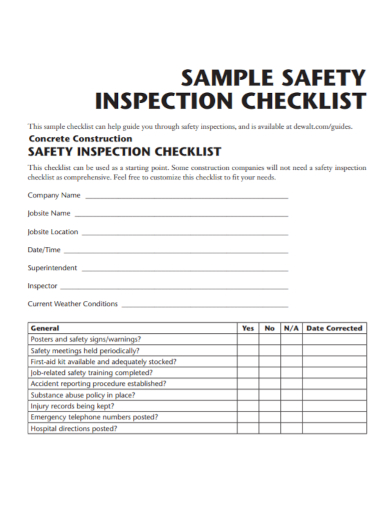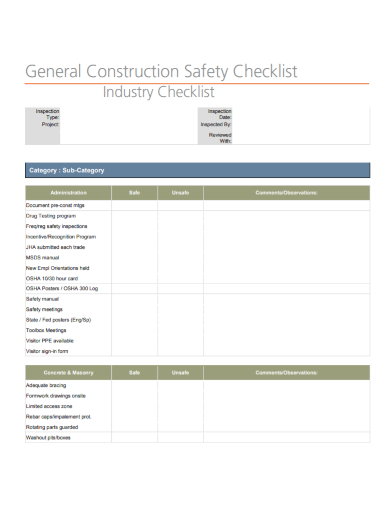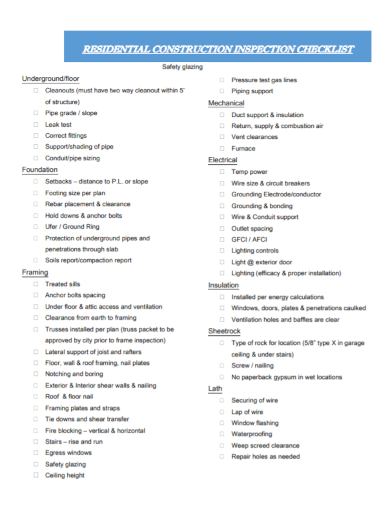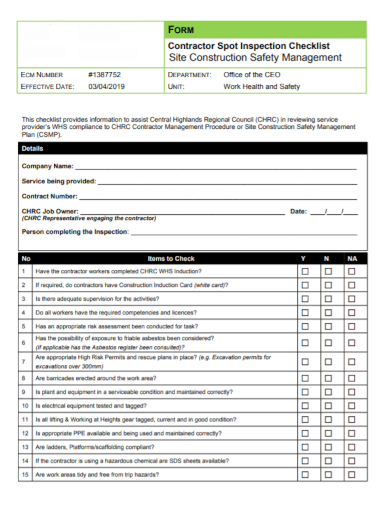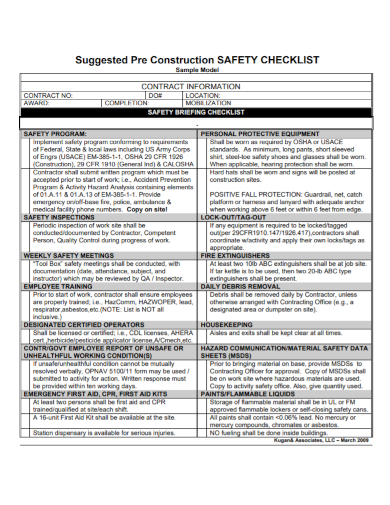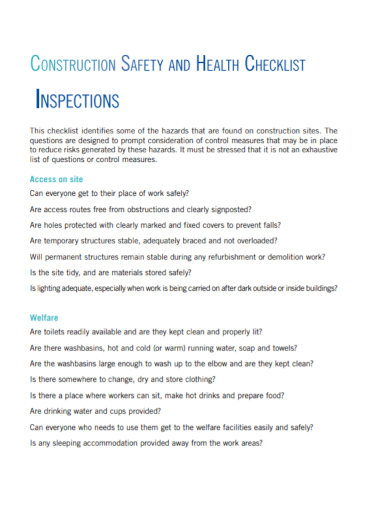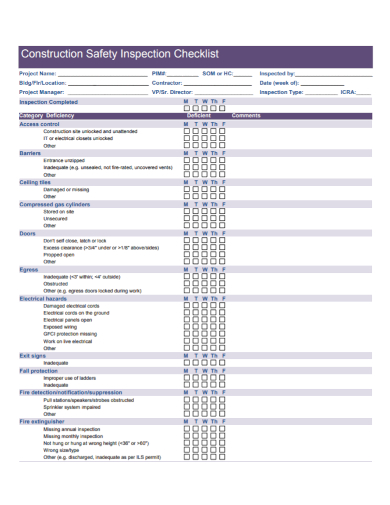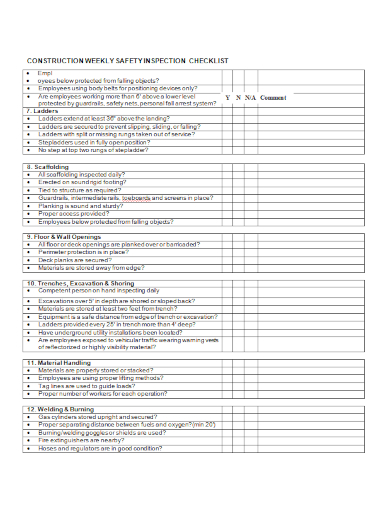Construction work areas need to have safety inspections to identify hazards. Inspectors are assigned to inspect the safety of the site and the best way to do their work efficiently is to have a checklist. The checklist writes down every important detail for inspections to make sure to cover everything and reduce any chances of mistakes and overlook important details that could possible lead a potential hazard.
10+ Construction Safety Inspection Checklist Samples
1. Construction Safety Inspection Checklist Template

2. Construction Site Safety Inspection Checklist
3. Concrete Construction Safety Inspection Checklist
4. Company Construction Safety Inspection Checklist
5. Construction Industry Safety Inspection Checklist
6. Residential Construction Safety Inspection Checklist
7. Construction Safety Management Inspection Checklist
8. Pre Construction Safety Inspection Checklist
9. Construction Health and Safety Inspection Checklist
10. Construction Project Safety Inspection Checklist
11. Construction Weekly Safety Inspection Checklist
Importance of Safety in Construction
Construction safety inspections are done to expose bad habits and hazardous site conditions and help correct them. Inspectors can be supervisors or safety officers who will go around the site regularly to observe the work in progress, document safety violations, and implement corrective actions.
When a regular inspection is done, worker safety will increase making the workers feel safe to continue their work. They are more likely to stay on a jobsite where they are assured nothing bad can happen to them. It can also help increase performance productivity since the operations won’t be interrupted due to incidents and accidents. It can also help the site give clear inspection documentation to regulatory agencies to assure that you are following the safety laws and regulations.
How to Create a Construction Safety Checklist
The checklist will be used by you, as the inspector to see if the construction site always follows the safety protocols. The checklist should be written on a sheet of paper or two and on the top part should include the names of the inspector and the contact person of the project, the date of the inspection, and the location of the construction project.
The checklist should be organized on a table with two columns; the left side must have the details of what the construction site should do for safety and the other column is where the inspector gives his remark; depending on the inspector’s way of evaluation. After all, that’s done, it’s time to write the rest of the checklist.
1. Write Down the Details to Include in the Checklist
The information below is some examples of what you could input into your checklist. Make a subheading on each category:
- Personal Protective Equipment (PPE): Has the correct gear been distributed to all workers? Are the equipment and correct gear in good condition and have they been distributed to all workers?
- Tools and Equipment: Are they in proper working order? Do the workers use the right tool for the job?
- Ladder and Stair Safety: Are fall protection methods followed? Are they safe to use and properly placed?
- Protective Devices and Signs: Are workers working in quite dangerous areas are surrounded by protective support to protect themselves and others? Are the safety signs and warnings easy to read and visible?
- Electrical Safety: Are all electrical cords in the site safely placed? Is there proper lighting in every corner of the site? Is temporary electricity such as a generator safely installed?
- Scaffolding: Is the scaffolding tied to the structure and is it secure?
- Confined Spaces: Are air monitoring equipment calibrated? Are there any rescue and retrieval equipment available on-site in cases of emergencies?
- Compressed Gasses: Are the compressed gas cylinders securely stored?
- Excavation: Are the workers designated for excavation work properly trained?
- General Safety: Is general housekeeping done regularly to keep the site neat and orderly? Are the emergency phone numbers posted and available to all? Is the first aid kit available at the worksite? Are fire extinguishers readily available? Are exits marked and not blocked by any obstructions?
2. Include a Corrective Action Plan Sheet
If some parts of each safety category haven’t been followed and complied with properly, the inspector is responsible to guide the workers to do corrective action. To do this, the inspector will provide a corrective action plan sheet. The sheet must comprise the action item to be done, the name of the person responsible to do it, and the date that it is due to comply.
FAQs
What are the safety requirements for construction?
Some of the safety requirements for construction work is for workers to wear PPE at all times, keep a tidy and clean site, avoid putting others in risky situations, follow safety signs and procedures, avoid working in unsafe areas, never tamper with equipment, and report defects in machinery and incidents right away.
What is general safety?
General safety is a disciplinary approach to develop and ensure compliance of safe working practices and maintenance of health and well-being of employees of a workplace with regulatory agencies.
What are the elements of safety?
The five elements of safety are leadership, responsibility, and accountability.
When doing the inspection make sure to draw your attention if there is any presence of immediate danger. Ask the workers to demonstrate equipment use and their general work in the construction. Make sure to closely and methodically inspect every area and work process. Conduct interviews to ask questions and discuss any potential problems or hazards in the workplace with the workers in their free time. Record everything with your camera and recorder. To help you get started making your own checklist, you can download our free sample templates above as your reference.
Related Posts
FREE 17+ Survey Checklist Samples in MS Word | Google Docs | PDF
FREE 18+ Background Checklist Samples in MS Word | Google Sheets | PDF
FREE 18+ Facilitator Checklist Samples in MS Word | Google Sheets | PDF
FREE 18+ Complaint Checklist Samples in MS Word | Google Sheets | PDF
FREE 18+ Internship Checklist Samples in MS Word | Google Docs | PDF
FREE 18+ Statement Checklist Samples in MS Word | Google Sheets | PDF
FREE 20+ Voluntary Checklist Samples in MS Word | Google Sheets | PDF
FREE 18+ Summary Checklist Samples in MS Word | Google Sheets | PDF
FREE 14+ Sponsorship Checklist Samples in MS Word | MS Excel | PDF
FREE 18+ Conference Checklist Samples in MS Word | Google Sheets | PDF
FREE 17+ Lesson Checklist Samples in MS Word | Google Sheets | PDF
FREE 18+ Progress Checklist Samples in MS Word | Google Docs | PDF
FREE 18+ Enrollment Checklist Samples in MS Word | Google Docs | PDF
FREE 18+ Graduation Checklist Samples in MS Word | Google Sheets | PDF
FREE 15+ Consent Checklist Samples in MS Word | Google Sheets | PDF
